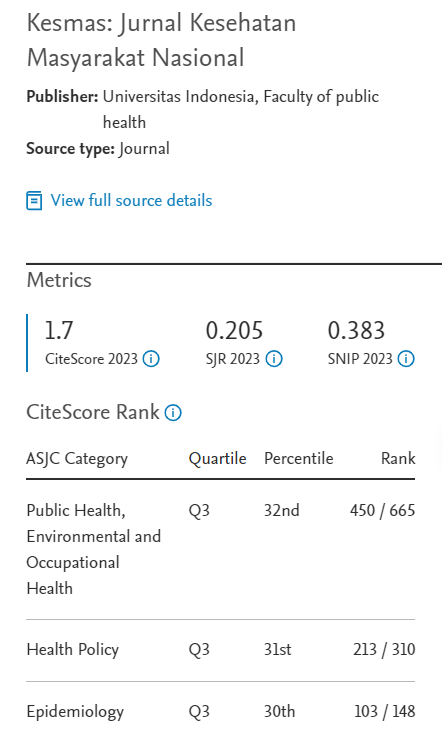Abstract
Pada penelitian survei, kita dapat mengukur tingkat status sosio-ekonomi rumah tangga melalui pemasukan, pengeluaran dan kepemilikan barang-barang berharga. Penggunaan variabel pemasukan dan pengeluaran di negara berkembang memiliki banyak kelemahan, sehingga banyak peneliti lebih suka menggunakan variabel kepemilikan barang berharga untuk mengukur status sosio-ekonomi. Namun, penggunaan variabel kepemilikan barang berharga menimbulkan masalah lain, yaitu banyaknya variabel untuk mengukur status sosio-ekonomi. Tujuan penulisan ini adalah menyederhanakan banyak variabel kepemilikan barang berharga menjadi 1 indeks sosio-ekonomi. Data yang digunakan adalah data Survei Demografi Kesehatan Indonesia 2002-2003 yang memiliki 7 variabel binomial tentang kepemilikan barang berharga dan 3 variabel ordinal tentang keadaan rumah untuk membuat indeks sosio-ekonomi. Indeks dibentuk dengan menggunakan principal component analysis (PCA), korelasi tetrakorik dan polikorik. Kami memperlihatkan bagaimana membuat indeks sosio-ekonomi dengan bantuan perangkat lunak Stata. Matriks korelasi tetrakorik dibentuk dengan perintah tetrachoric dan matriks korelasi polikorik dibentuk dengan perintah polychoric. Dua indeks sosio-ekonomi dibentuk, 1 indeks berdasarkan 7 variabel binomial kepemilikan barang berharga dan 1 indeks lagi berdasarkan ke 7 variabel binomial tersebut ditambah 3 variabel ordinal kondisi rumah. Kedua indeks dibentuk dengan prosedur PCA. Pada model 7 variabel binomial, indeks yang terbentuk dapat menjelaskan 57% varians kepemilikan barang berharga dan pada model 7 variabel binomial ditambah 3 variabel ordinal, indeks dapat menjelaskan 54% varians kepemilikan barang berharga dan kondisi rumah. Kami juga memperlihatkan penggunaan perintah xtile untuk membagi subyek penelitian menurut kuintil indeks sosio-ekonomi. PCA, korelasi tetrakorik dan polikorik dapat digunakan untuk membentuk indeks sosio-ekonomi berdasarakan informasi tentang kepemilikan barang berharga dan kondisi rumah.
In household survey, we could measure socio-economic status through income, expenditure and ownership of valuable goods. Measuring income and expenditure in developing countries has many weaknesses, therefore many researchers prefer to use the ownership of valuable goods as proxy of socio-economic status. Using ownership of valuable goods as proxy indicator creates another problem of having many variables for the socio-economic proxy. To show how to simplify many variables of ownership of valuable goods into 1 socio-economic index. Using principal component analysis with Stata. Using Indonesia Demographic & Health Survey 2002-2003 data, 7 binomial variables of ownership of valuable goods and 3 ordinal variables of housing condition to construct socio-economic indices using principal component analysis (PCA), tetrachoric and polychoric correlation.We used Stata to construct the socio-economic index. Correlation matrices were derived using tetrachoric command for tetrachoric correlation and polychoric command for polychoric correlation. Two socio-economic indices were constructed, 1 index was based only on 7 binomial variables of ownership of valuable goods and 1 index was based on 7 binomial variables of ownership of valuable goods and 3 ordinal variables of housing conditions. PCA was used to construct those 2 indices. In 7 variables model, the socio-economic index could explain 57% variance and in 10 variables model, the socio-economic index could explain 54% variance. We also showed the use of xtile command to regroup the subjects based on quintile of socio-economic indices. PCA, tetrachoric and polychoric correlation could be used to construct socio-economic indices based on information of ownership of valuable goods and housing conditions.
References
- Shimeles A, Thoenen R. Poverty Profile: A Methodological Note on Measuring Poverty. Makalah dipresentasikan pada ODI/ESPD Conference on Addressing Inequalities: Policies for Inclusive Development, Addis Ababa, 11-12 Juli 2005.
- Filmer D, Pritchett L (2001). Estimating Wealth Effect Without Expenditure Data or Tears: An Application to Eductional Enrollments in States of India. Demograpy 38, 115-132.
- Kolenikov S, Angeles G (2004). The Use of Discrete Data in PCA: Theory, Simulations and Applications to Socioeconomic Indices. Working paper WP-04-85, MEASURE/Evaluation Project, Carolina Population Center, University of North Carolina, Chapel Hill.
- Royce JR (1963). Factors as Theoretical Constructs. pada Jackson DN, Messick S (editor), Problems in Human Assessment. McGrawHill, New York.
- Kline P (1994). An Easy Guide to Factor Analysis. Routledge, London.
- Bollen KA, Glanville JL, Stecklov G (2002). Economic Status Proxies in Studies of Fertility in Developing Countries: Does The Measure Matter?. Population Studies, 56, 81-96.
- EQUINET 2003. Deprivation and Resource Allocation: Methods for Small Area Research. EQUINET, Harare.
- Garenne M, Garenne SH (2003). A Wealth Index to Screen High-risk Families: Application to Morocco. J. Health Population and Nutrition 21(3), 235-242.
- Barros AJ, Victora CG. A Nationwide Wealth Score Based on The 2000 Brazillian Demographic Census. Makalah dipresentasikan pada The VI Brazilian Congress of Epidemiology, Recfine, June 2004.
- Uebersax JS (2006). The Tetrachoric and Polychoric Correlation Coefficient. Diunduh dari http://ourworld.compuserve.com/homepages/juebersax/tetra.htm pada 25 Juli 2006.
- Stata Corp (2005). Stata Statistical Software: Release 9. Stata Press, College Station.
Recommended Citation
Ariawan I .
Indeks Sosio-ekonomi Menggunakan Principal Component Analysis.
Kesmas.
2006;
1(2):
83-87
DOI: 10.21109/kesmas.v1i2.317
Available at:
https://scholarhub.ui.ac.id/kesmas/vol1/iss2/6







